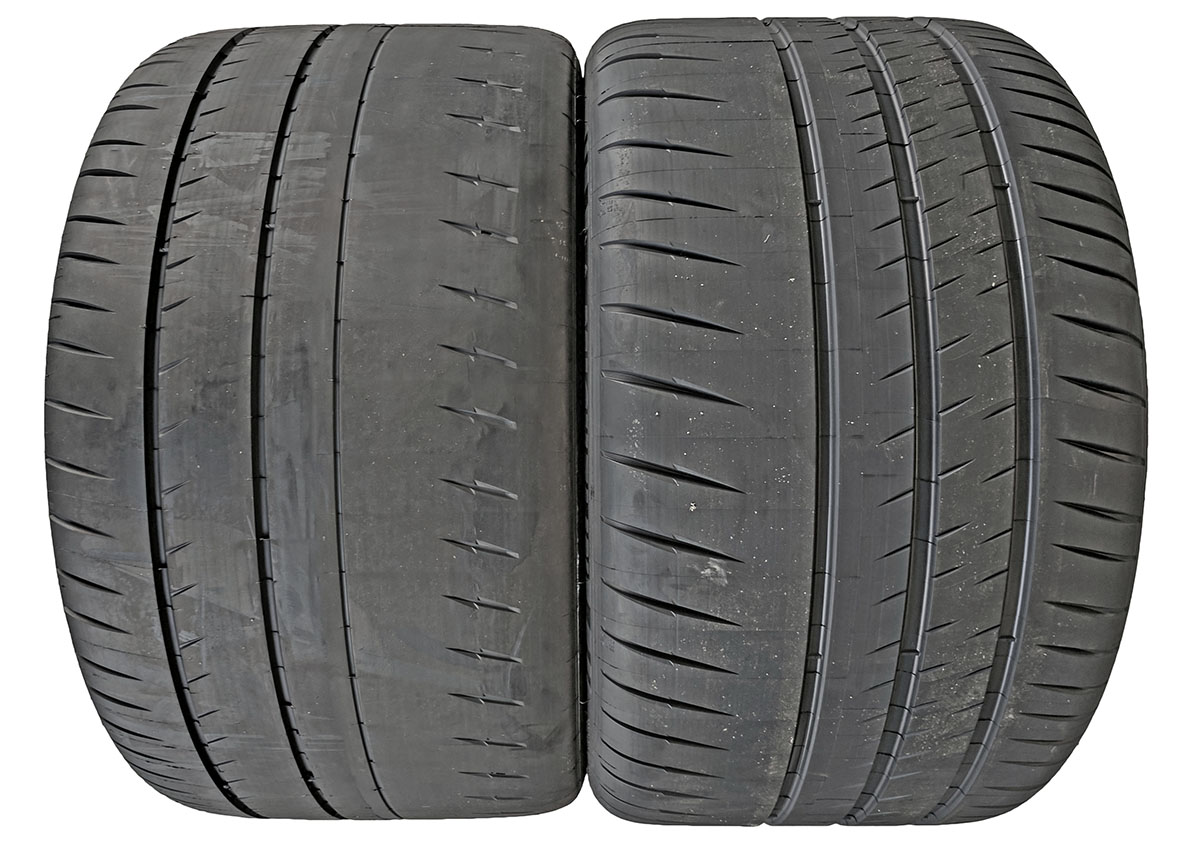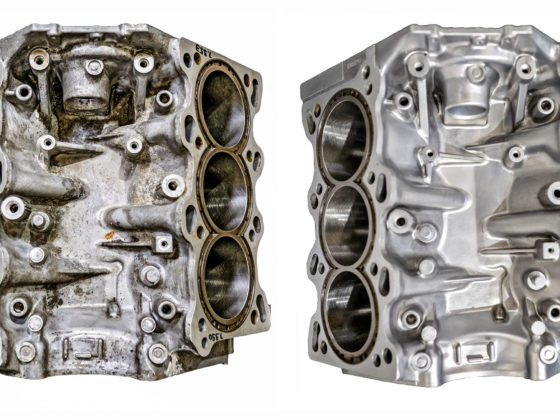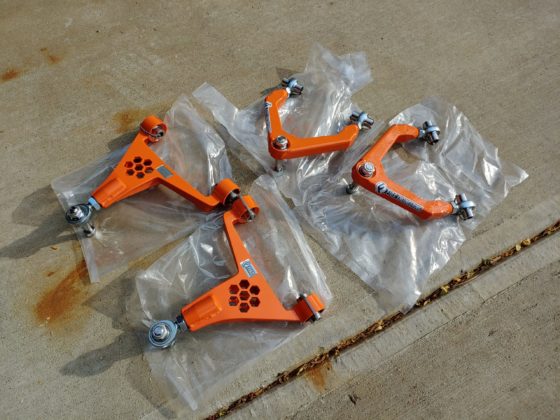Circumferential Grooves
Deeper and wider circumferential grooves and lateral slits increase the “Void Ratio” (the amount of material taken away from a full slick) and improves hydroplaning resistance at the cost of contact patch size. Compounding has a big effect in terms of wet grip but increasing the void ratio is purely a tradeoff between standing water hydroplaning performance vs steering response and overall dry performance. This is why some of the fastest and most aggressive Cup 2s do not have the same hydroplaning resistance as more street focused Cup 2s.
Due to the differing demands between performing in the wet and dry, a tire acts like two tires in one. The inboard placement and location of the grooves enables a large outer shoulder (like a slick-type racing tire) to improve dry grip, cornering performance, and durability on track since it gets the majority of load and pressure when cornering.
Meanwhile the inboard grooves are mostly in play during straight line driving and especially in the wet, where the tire does not roll over and load the outer half of the tire as much because of the reduced grip. The inner half tire also greatly affects steering response and straight-line driving.

There’s a reason when you look at many of Michelin’s tires (from the Cup 2, PS4S, PSS, and going back to the older days of the PS2 and earlier) the tires essentially look like ‘street’ or ‘rain’ tires on the inner half and more aggressive slicks on the outer half. There’s also a reason many tires in this category have slowly shifted towards this philosophy and tread layout for UHP and streetable track-focused tires.
Outer Shoulder “Features” and “Sipes”
The outer shoulder can have a varying amount of what Michelin calls “features” (any lateral groove across the tire) that many, including myself, would incorrectly call “sipes”. This is not technically correct since “sipes” are the very small hairline cuts in a tread block that provide micro biting edges in the rubber that deform and open up to suck in water to remove it from the contact path surface. They are designed to increase grip in low friction conditions like heavy rain and snow type conditions, but are not conducive for performance driving. These lateral features also create a path for water to exit the contact patch laterally, further improving hydroplaning and wet grip. The effectiveness of these depends on their depth and number around the circumference.

These outer “features” slightly improve hydroplaning resistance, provides an aesthetic look to put tire in certain family, and also affect the tread-induced noise the tire makes. Upon closer inspection, Michelin uses 3-4 different ‘pitches’, or width & distance between ‘features’, that through programming, can optimize pitches to reduce drone and tread induced noise.

Many Cup 2 tires made for Mustangs and Corvettes have wear hole indicators that are commonly used on racing tires.

The lateral groove “features” can easily be mistaken as the thickness of the tread and once they’re worn away, are often (incorrectly) assumed to be worn out when in fact they are designed to be worn away, look like a slick, and still have plenty of life left in them.
Cup 2 R:

Cup 2 R’s have an extremely shallow of a tread depth and just enough features to meet euro ECE wet & DOT certified wet. They are a single focus tire: dry lap times.
Table of Contents:
Page 1 – Intro, My Background, Developing Bespoke Tires
Page 2 – TREAD DESIGN – Tread Depth
Page 3 – TREAD DESIGN – Circumferential Grooves, Outer Shoulder Features & Sipes, Cup 2R
Page 4 – COMPOUNDING – Compound Variation Across Tread & Tread Depth, Cup 2R
Page 5 – CONSTRUCTION – Carcass Profile/Shape, Width, Ribs
Page 6 – CONSTRUCTION – Sidewall Stiffness, Run Flat Tires, Cup 2 Connect
Page 7 – How Tread Design, Compounding, and Construction Come Together
Page 8 – Conclusion




25 comments
So when someone modifies the suspension in any manner away from stock specs (ride height, alignement) can this tire to car relationship be considered to be out the window? The high level of engineering that went into that model-matched tire was meant to be applied to the factory spec model, no?
Yes and no.
For example, if you replace the super stiff factory carbon wheels on a GT350R, GT500 CFTP, Ford GT, Ferrari Pista with a lightweight (flexible) wheel, you will lose steering feel, grip, response, and will need A LOT more static negative camber. All of these degrade performance and feel from what was originally designed. You can read more about this here:
https://motoiq.com/tested-carbon-revolution-carbon-fiber-wheels/
Making the car lighter is a positive all around.
Lowering the car is a positive but if the car’s balance changes from changing the roll centers, springs/bars/damping, alignment, weight distribution, aero, power, etc…) then the car will obviously not handle the same and will ‘work’ the tires differently. If your new setup or alignment makes the car understeer more, the front tires will wear out faster and a wider front tire could be advantageous.
Overall, if an OEM bespoke tire is better than a given aftermarket tire (or wider tire of the same model, but a less aggressive compound) in stock form, it will likely continue to be better in most situations on a modified car.
Basically what I end up explaining to my clients a lot is we are setting up your suspension for the tires you are running. If you change the tires the setup will change.
The bane of our lives!
And it gets worse for older cars: Smaller diameter wheel and tire sizes are becoming rarer and rarer. So a car with a good setup can become a car with no setup as x tire becomes unavailable.
Then again: I’m only really compaining for my own cars, not the ones of clients!
Preach Big Beautiful sideWalls brother! I don’t need them skinny runflat tires, it’s those meaty black beauties that scrub my contact patch!
Beautiful article! I’ve seen so many drivers go to what they believe will be a more aggressive tire only to go back to their previous setup because the new tire “just sucks” and they have no idea why.
Thanks for updating your How to Properly Select Tires article by the way, it’s a great resource, the only thing missing is how to find tires that work with FWD, negative scrub radius cars. The new Type Rs much through their conti SC6s.
Thank you !
Great article….thanks! I have a follow up GT350R question: What would you recommend if running running a square set-up (HPDE use only) in an attempt to keep consumable cost down or is it overall best to run the the 305/315 setup regardless? Also if running the factory tire set-up I’d assume fronts would cord before the rears would heat cycle out…would fresh set of fronts dramatically effect handling if used with rears with plenty of tread/heat cycle left?
Duane
I would love an answer to this also. I am on the cusp of buying 4S to replace the cup 2s on my 2020 R, but want to go square for rotation purposes (unmount/remount F to R). Now that I see the Base 350 has a different tread depth than the R I wonder if life would be slightly higher. If so, I would consider going 305 square with the base 350 cup 2. Also, how do I determine which 305 is the R and which is the base, in case I don’t go through Ford?
The base GT350 Cup 2 is a “35” sidewall (and is a 295/305 stagger) while the “R” has a shorter “30” sidewall (and is a 305/315 stagger). If you’re going with a square setup, I would choose the rear tire all the way around. (GT350R’s 315/30-19 or the base GT350’s 305/35-19).
The base Cup 2 has more tread depth than the R’s Cup 2, but is a slower tire. When driven at the limit, it won’t really last any longer, but if driven below the limit, it will likely last a little longer. If you’re tracking your car, the base Cup 2 tire will have more grip and perform better than the PS4S in everything but deep standing water.
If you are running the stock wheels and tires and track alignment, and aren’t driving with bad technique, the tires will wear out pretty evenly front and rear. If you’re running lightweight aftermarket wheels, you’ll need more camber than the Ford recommendation.
Billy,
This was a great and educational article! I have a 2020 GT350R that I currently do not track. I am going to be replacing the factory MPSC2 tires and will not be getting the same tires again because I mainly street drive and for me, these tires are not ideal in the rain. I am considering getting the MPS4S tires as a replacement. I see that you recommend going with 315’s all around for a square set-up in the GT350R. I do plan, however, to continue to use my factory CF wheels and do not like the idea of unmounting and remounting for tire rotations with these specific wheels. With the information in your article that you provided, would I be ok with using a 295/30/19 in the front and 305/30/19 in the rear with the MPS4S on my CF wheels? Thank you in advance!
Loved the article, thought it was well done!
Thanks for the feedback!
Loved this article!
I currently have a 2018 GT350 with PSS.
When I upgrade the tires, should I get the original bespoke PSS, or would I get better performance if I switch to PS4S?
Luis,
I’m in the same boat, but my guess would be going to the bespoke Ford Sport Cup 2s on the 2019 generation and later GT350. However, 2019 models did have a change in shocks and sway bars, ABS settings, etc to use the more sticky compound.
The 2019 bespoke Cup 2 has the best wet and dry grip. An off the shelf PS4S has the best hydroplaning resistance for deep water. The 2015-2018 bespoke PSS has similar/marginally better hydro than the newer Cup 2, but it’s not as sticky in the wet or dry than the Cup 2, but sticker than the PS4S.
Absolutely superb article! This is the kind of semi-technical info that all track day enthusiasts need and is hard to find out there, that you very much!
Thank you 🙂
What a fantastic article (so much info I wish it was a video). I’m presently looking for a Cup2 Connect tire I saw that is wider than normal for its spec, but no one at Michelin has been able to help me with it. Keep up the good work sir.
Thank you for the compliment. Will do!
Thank you for your excellent and most informative article. I have a 2019 Shelby GT350 with the bespoke Cup 2 tires. Given that the GT350 is designed for more daily road use and less track use than the GT350R, are the GT350 bespoke Cup 2 tires also better able to handle the occasional standing water that occurs on roads and freeways than those designed for the GT350R? My primary interest is in being able to keep the original Cup 2 tires while also using the car as a possible daily driver in rainy winter weather without being excessively concerned about hydroplaning. Having read your article, I have greater confidence that I don’t need to rush out and replace the Cup 2s with Michelin PS4Ss or Pirelli P Zero Sports. But if I have misunderstood your article, and shouldn’t keep the Cup 2s for daily all winter (no snow) use, please let me know. Your thoughts on this would be most appreciated.
Excellent article, thank you. I’ve been researching tires for my GT3 RS, which comes with Sport Cup 2s. Your article taught me much more than I expected and showed me how much more there is to know than I imagined.
Thank you for the feedback. I’m glad to hear it was informative 🙂
I just discovered your site and am in awe at both the high level and quantity of useful information you and your team have built up.
I’ve been in analysis paralysis choosing tires for my 2016 M235i coupe for a month now and need some help. (God I hate that they reused M235i for the new “Gran Coupe”) I’m thinking of moving to 235/40 PS4S on some sweet BimmerWorld 18×8.5″ TA5R wheels and see that there’s both a standard and a Ford OE DT1 version of the PS4S. I think the DT1 was OE on the Ford Focus ST or a Mustang, but it is really hard to get information.
This excellent article and the great article and video by TyreReviews on BMW’s custom PS4S tires for the new G80 M3 and G82 M4 have vastly improved my education on OE vs off-the-shelf tires, but unfortunately has increased my purchasing anxiety…
https://www.tyrereviews.com/Article/Should-I-Fit-OE-Tyres.htm
S the only differences in specs on the DT1 version I’ve found are 0.5/32″ shallower and 0.3″ narrower tread as well as a HUGE 1.9 lbs weight savings. By my calculations, the narrower tread width would account for only about 1/3 lb weight savings so it leaves me wondering where the rest of the weight savings came from. That relatively large weight savings is fairly attractive, more for handling feel and comfort than raw lap times, but I’m worried that Ford/Michelin may have optimized the DT1 for something that I care less about.
With your direct experience testing Michelin tires on Ford performance cars, and maybe even directly on this DT1 variant of the PS4S, what insight do you have on what differences the DT1 may have and whether it would be a better fitment for my M235i?
Should I also worry about the narrower 7.8″ DT1 vs 8.1″ ‘normal’ tread width? Would 7.8″ tread width be too stretched on a 8.5″ wheel?
For reference, my M235i is my DD and is stock so far but I will be getting back into some autocross once I replace my aging run-flats and have aspirations to do a few track days. Boyish dreams of drifting too, but that may never actually happen with my budget, wife approval factor, and lack of an LSD 😉
Sorry about the double/triple post, my formatting was totally lost on my other post attempts and I’m trying to make my huge block of text more readable. Hopefully this one comes through better.
——————————————————————————–
I just discovered your site and am in awe at both the high level and quantity of useful information you and your team have built up. I’ve been in analysis paralysis choosing tires for my 2016 M235i coupe for a month now and need some help. (God I hate that they reused M235i for the new “Gran Coupe”)
——————————————————————————–
I’m thinking of moving to 235/40 PS4S on some sweet BimmerWorld 18×8.5″ ET38 TA5R wheels and see that there’s both a standard and a Ford OE DT1 version of the PS4S. I think the DT1 was OE on the Ford Focus ST or a Mustang, but it is really hard to get information. I currently have 225/40R18 and 245/35R18 P-Zero run-flats on the stock 18×7.5/8″ wheels.
——————————————————————————–
This excellent article and the great article and video by TyreReviews on BMW’s custom PS4S tires for the new G80 M3 and G82 M4 have vastly improved my education on OE vs off-the-shelf tires, but unfortunately has increased my purchasing anxiety… ——– https://www.tyrereviews.com/Article/Should-I-Fit-OE-Tyres.htm
——————————————————————————–
So the only differences in specs on the DT1 version I’ve found are 0.5/32″ shallower and 0.3″ narrower tread as well as a HUGE 1.9 lbs weight savings. By my calculations, the narrower tread width would account for only about 1/3 lb weight savings so it leaves me wondering where the rest of the weight savings came from. That relatively large weight savings is fairly attractive, more for handling feel and comfort than raw lap times, but I’m worried that Ford/Michelin may have optimized the DT1 for something that I care less about.
——————————————————————————–
With your direct experience testing Michelin tires on Ford performance cars, and maybe even directly on this DT1 variant of the PS4S, what insight do you have on what differences the DT1 may have and whether it would be a better fitment for my M235i? Should I also worry about the narrower 7.8″ DT1 vs 8.1″ ‘normal’ tread width? Would 7.8″ tread width be too stretched on a 8.5″ wheel? What about the ~6mm increase in scrub radius according to — https://www.wheel-size.com/calc/?wheel1=225-40-18X7.5ET45&wheel2=235-40-18X8.5ET38&fcl=11mm&scl=15mm&wcl=57mm&sr=0mm ? Sorry about all the questions and thanks in advance for your help!!!
——————————————————————————–
For reference, my M235i is my DD and is stock so far but I will be getting back into some autocross once I replace my aging run-flats and have aspirations to do a few track days. Boyish dreams of drifting too, but that may never actually happen with my budget, wife approval factor, and lack of an LSD 😉
Thanks for this great article. Somehow I missed it over the past few years. I thought I was losing my mind as the Sport Cup 2 groove depth was much deeper on my friends Ferrari than my 2017 Z06 (with Z07). We all know SC2,s are very pricy. I’ve gone through a few sets over the years, changing the alignment to track settings a few years ago (per owners manual track setting recommendations). I primarily only use the car for the track. The hope with the track alignment (pretty much -2 all around), was to get the best track performance possible but also to gain tire life. My question is should I seek a set of SC2s that have the deeper grooves (to gain some tire life, even at the risk of losing a bit of track performance), or do you recommend I stay with the ones GM recommends?
Many thanks.